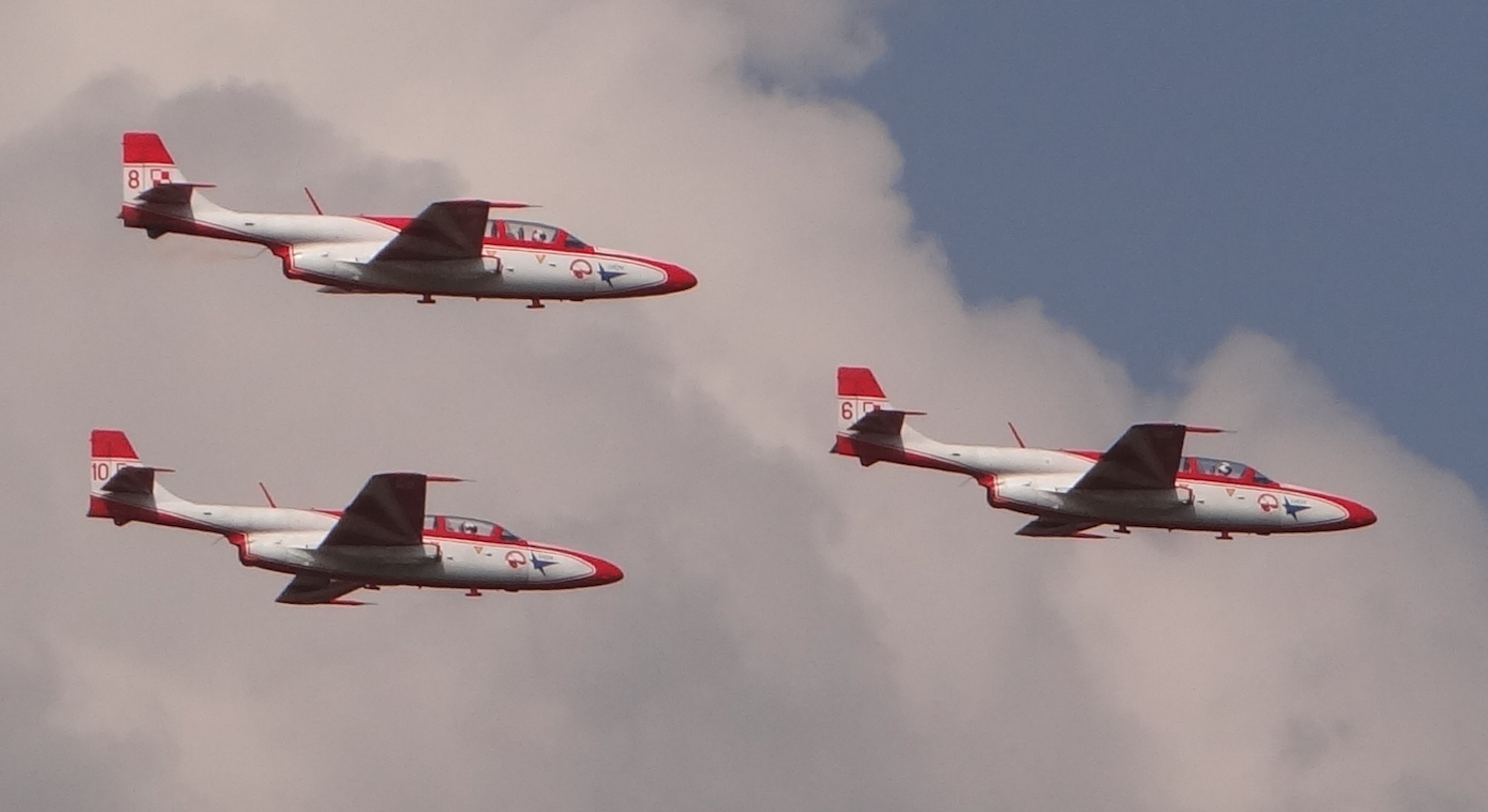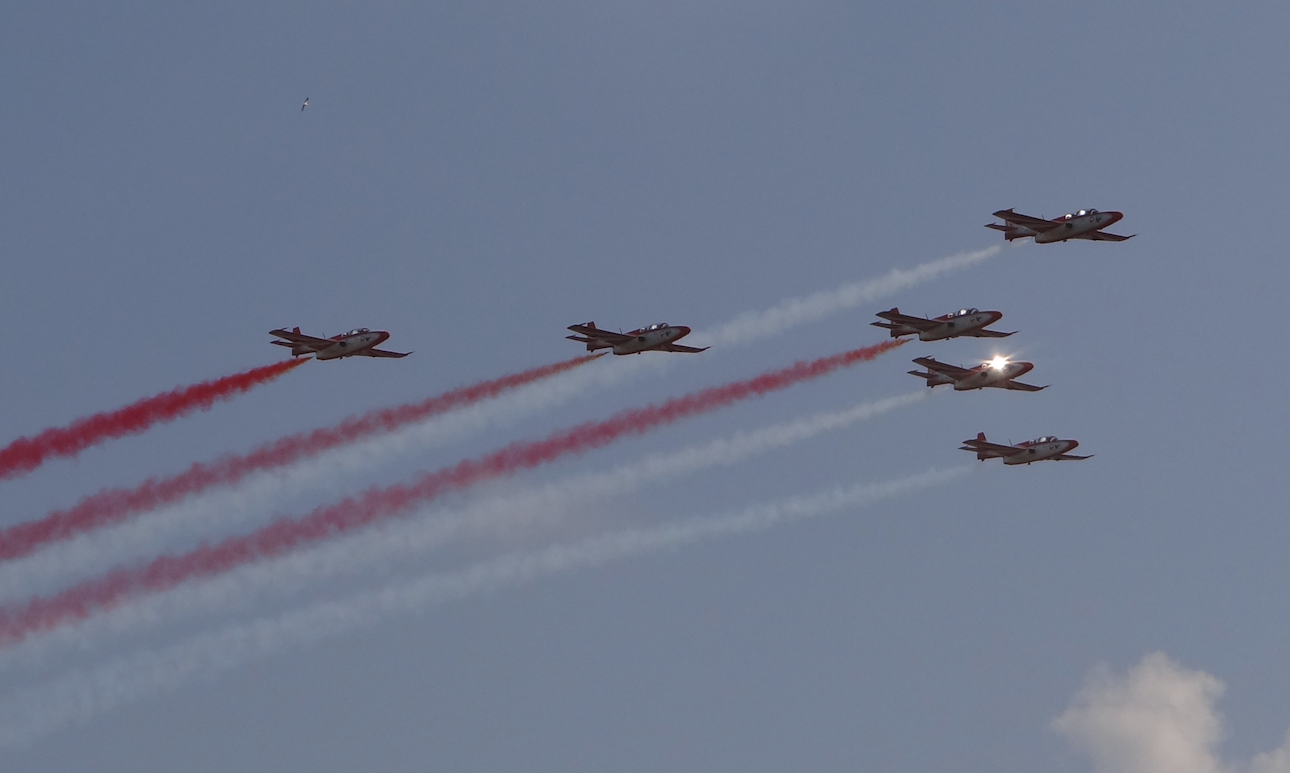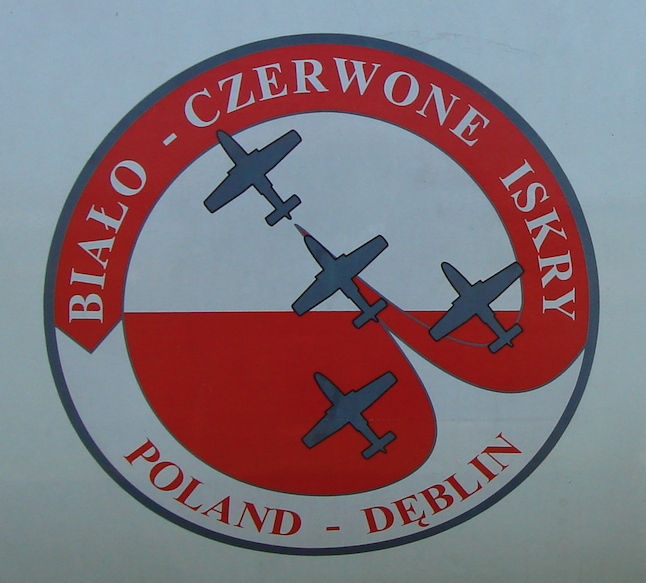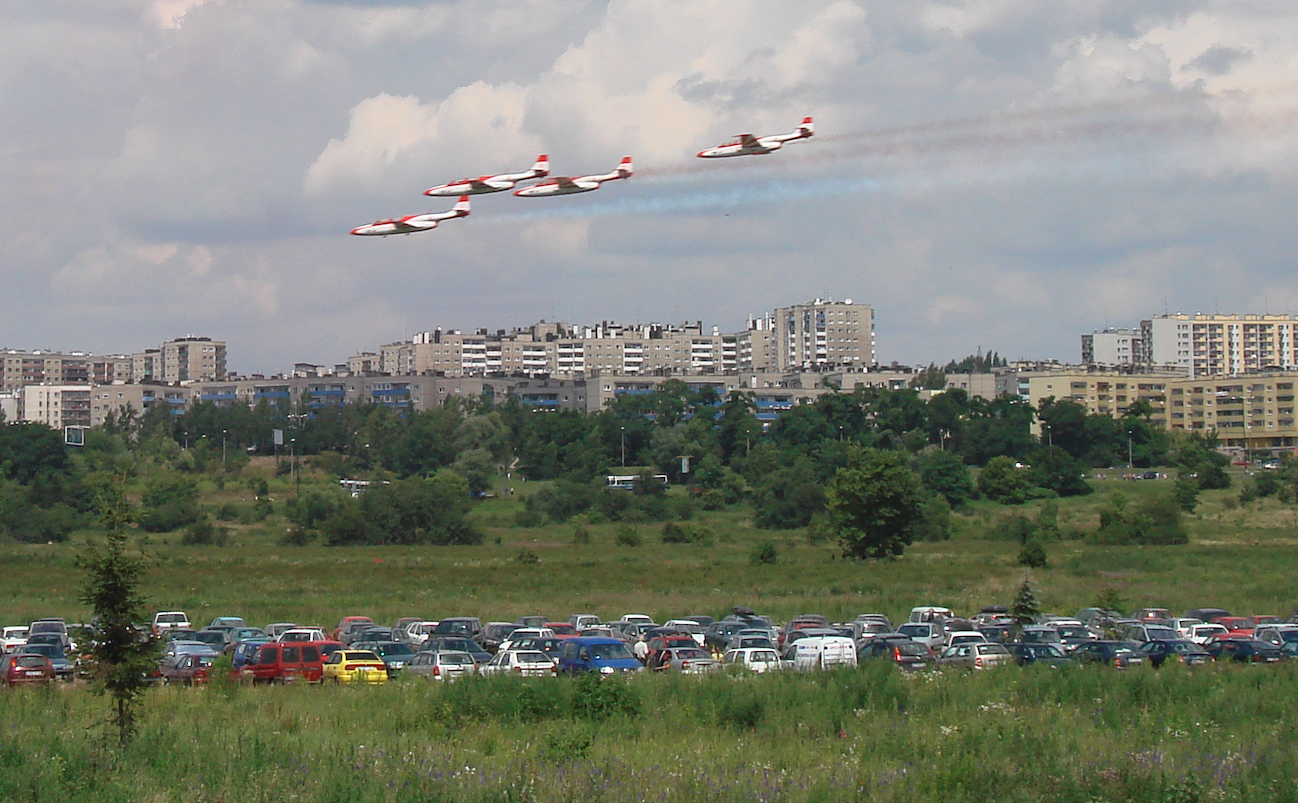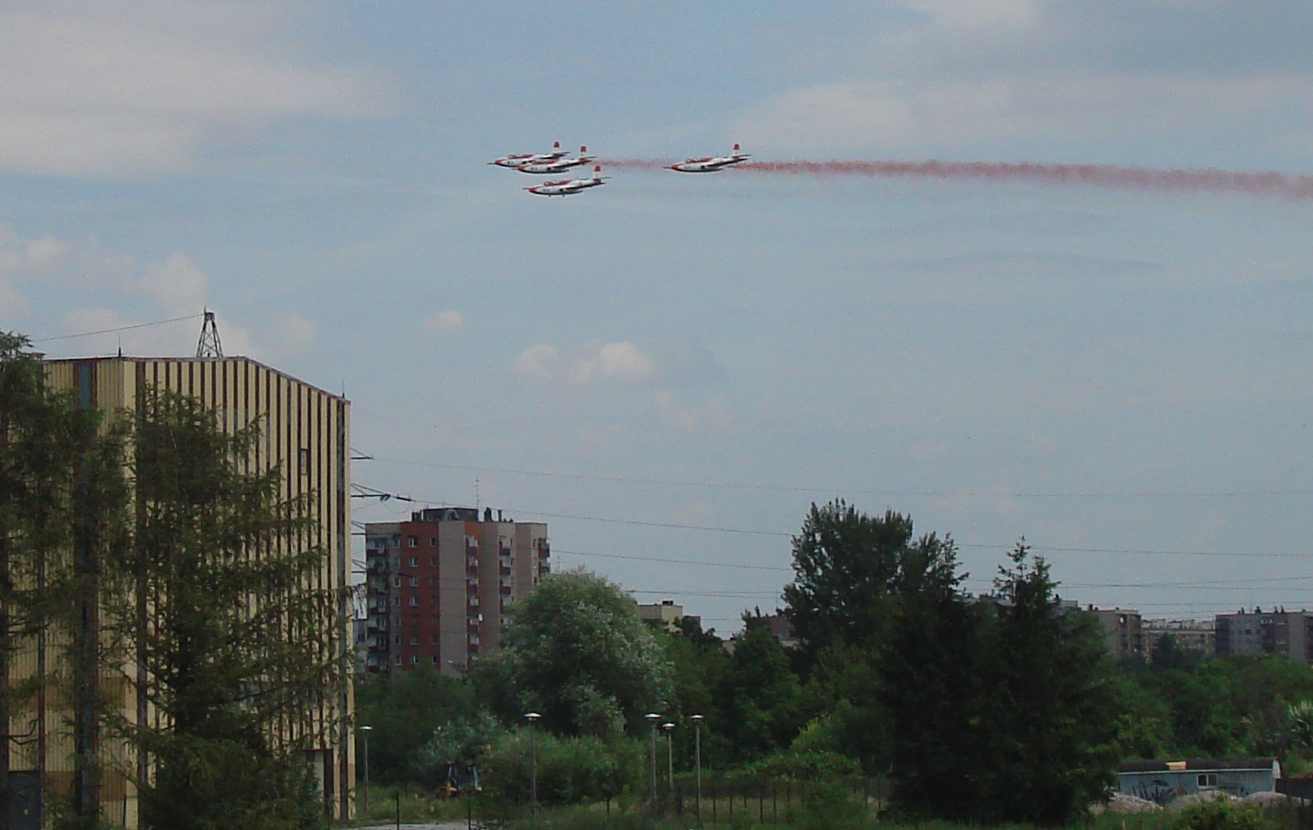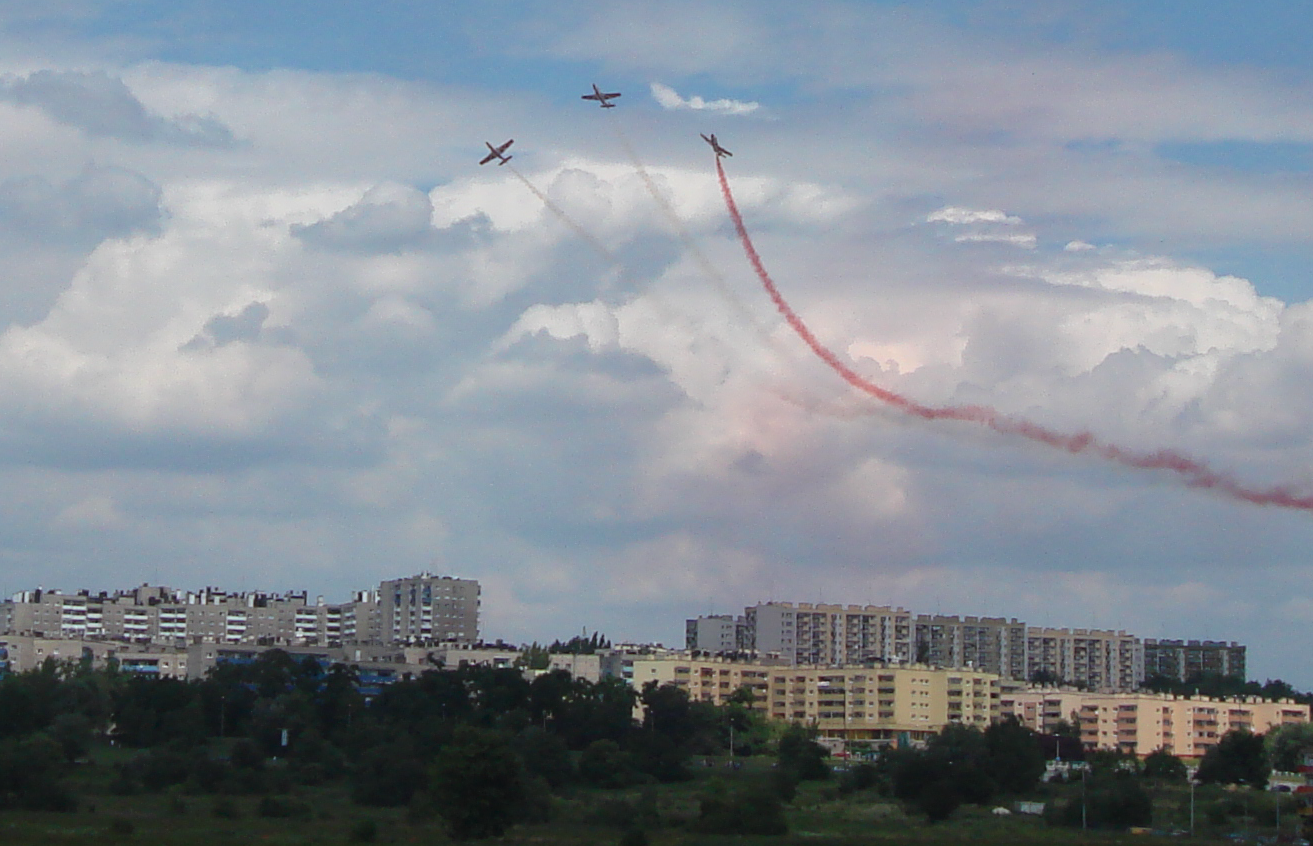Kraków 2020-05-08
White and Red Sparks.
Pre-war traditions.
The tradition of aerobatic flights in the Polish Army dates back to the second half of the 20th century, when experienced pilots in air regiments performed joint acrobatics. However, the most famous was the "Kraków Aerobatic Troika", with pilot officers: Jerzy Bajan, Karol Pniak and Stanisław Macek, who flew PWS-A fighters.
The first aerobatic groups.
After World War II, there was a stagnation in the Polish Army for several years. It was only after the wave of changes initiated by the Poznań Uprising that fighter pilots began performing team aerobatics. The first pilot group was formed by pilots from the 1st Fighter Aviation Regiment in Mińsk Mazowiecki. The group was led, among others, by pilot major Lucjan Kałkus. The group gave shows, among others, at the Rakowice-Czyżyny airport in Kraków and Poznań-Ławica. Also in 1956, groups were formed in; 62nd Fighter Aviation Regiment in Krzesiny (Pilot Lieutenant Czesław Bil, Pilot Captain Józef Sobieraj), 41st Fighter Aviation Regiment in Malbork (Pilot Lieutenant Edward Nachman) and 29th Fighter Aviation Regiment in Orneta (Pilot Captain Franciszek Walenty). In 1958, a group called "Romb" was established at the Wrocław-Strachowice airport. The group was led by major pilot Władysław Hermaszewski. The group performed shows until 1963. At that time, pilots flew mainly PZL Lim-2 and PZL Lim-5 aircraft.
PZL Lim-2 Smugacz.
It is worth paying attention to a variant of the PZL Lim-2 aircraft called "Smugacz". To increase the attractiveness of air shows, it was decided to use smoke trailing behind the plane. Initially, smoke candles were used. But smoke candles only worked for a short time, and once used, the candle was an unnecessary element. It was necessary to develop a device that would produce smoke exactly when the pilot wanted it.
Such a device was developed by Lt. Col. Zenon Klimkowski, M.Sc. Engineer. The fuel installation of the PZL Lim-2 aircraft was deprived of the rear fuel tanks in the aircraft fuselage. Two pressure tanks were inserted here. The first one was filled with oil and was used to obtain white smoke, the second one was filled with a red emulsion and was used to obtain red smoke. The liquids passed through hoses to the injectors located behind the engine turbine. The liquid supply was enough to produce colored smoke for about 5 minutes, which was enough time.
The history of the "Biało-Czerwone Iskry" band.
In 1964, the first serial PZL TS-11 Iskra aircraft were received by the OSL (Officers’ Aviation School) school in Dęblin, and the aircraft were based at the Radom-Sadków airport. More planes were sent to air training regiments. The main purpose of the aircraft was and is initial training of pilots on jet aircraft, training before flights on combat aircraft and learning and training in full aerobatics. In 1969, in the 60th Aviation Training Regiment in Radom, a team flying PZL TS-11 Iskra aircraft was established. The team was named "Rombik" because it flew on 4 planes, creating a rhombus-type figure.
The first pilots of the group were: Capt. pil. Janusz Łodziński (leader), captain pil. Edmund Wujec (right led), Capt. pil. Kazimierz Kuźniar (left led) and Capt. pil. Jan Karpiński (closing).
In 1991, the team adopted the official name "Iskry Aerobatics Team". Also in 1991, PZL TS-11 Iskra aircraft were modernized, equipped with a world-class radio and navigation system, transponder, ILS and VOR receivers, and painted in national colors according to the design of Lt. Col. pilot Ireneusz Fibinger. The planes are equipped with the necessary equipment and a smoke generator installation, which allows the generation of contrails in two colors – red and white. In place of the dismantled cannon, a tank containing 70 liters of smoke-generating liquid was built. Due to the modernization, an additional reduction in the aircraft’s weight was achieved, which resulted in increased maneuverability. The PZL TS-11 Iskra plane (except for No. 1, which has a weaker engine) has a more powerful engine: SO-3W with a thrust of 1,100 KG. The aircraft’s fuel system allows for a 40-second flight in the inverted position. The team was developing and by the end of the 1990s it was already flying in a formation of 9 planes.
In March 2000, the team was transferred to Dęblin to the 1st Aviation Training Center, which is an integral part of the Air Force Academy. At this time, the band’s name changes to "Biało-Czerwone Iskry". A new logo was also designed, the graphics of which refer to the national colors.
In 2007, the PZL TS-11 Iskra aircraft No. 1H 0730, in the nb 1 team, which was piloted by the team commander, ended its service life and was transferred by the army to the Polish Aviation Museum in Krakow.
Since January 1, 2011, the "Biało-Czerwone Iskry" team has been subordinated to the 42nd Training Aviation Base. captain pilot Franciszek Żwirka and engineer. Stanisław Wigura. In 2011, the 41st Training Aviation Base had 41 PZL TS-11 Iskra aircraft. During this time, 8 aircraft reached the end of their service life because they had completed 35 years of service. The last planes will end their service life in 2025. In 2009, the costs of propellants and lubricants for PZL TS-11 Iskra per flight hour (2009) amounted to PLN 1,397.5. The total operating cost (maintenance, instructor, insurance, depreciation) per flight hour is PLN 2,740.12.
The composition of the "Biało-Czerwone Iskry" team in 2011: Pilot Major Jacek Jaworek, right pilot Major Pilot Mariusz Szymla, left captain Captain. pilot Tomasz Łukaszczuk, second right led by captain pilot Tomasz Czerwiński, second left led by captain pilot Mirosław Kopeć, closing major pilot Dariusz Karwowski, closing and individual pilot captain pilot Maciej Kopiel. Commentator Capt. pilot Paweł Wichowicz.At this time, the team operates with six, seven or four PZL TS-11 Iskra aircraft. Since 2016, the "Biało-Czerwone Iskry" team has been operating with six planes.
Over the years of operation of the team, the personal, organizational and quantitative composition has changed. All team pilots are experienced instructor pilots. The pilots have the highest qualifications and extensive aviation experience. During training and during shows, they perform very difficult and dangerous stunts.
The "Biało-Czerwone Iskry" group gives over twenty shows per season, in Poland and abroad. In 2017, the team was in Gracja. Previously there were European countries from the UK to Turkey. The most popular arrangement is "Flaga", which is performed during flights. The show includes: passing, parting ways, mirror flight, inverted spin, "heart" and others.
In Poland, there is no comfort that an aerobatic team only deals with demonstrations and training of its successors. Polish pilots must treat work in the "Biało-Czerwone Iskry" team as a passion and devote their free time. That is why it is difficult to recruit successors, because local pilots know what is behind it, and there is no way to encourage pilots from other units to work in the team. That is why we surround these pilots with respect and prayer. They are patrons of the Republic of Poland. The "Biało-Czerwone Iskry" Aerobatic Team includes not only pilots, but also service technicians who prepare planes for takeoff. It is thanks to their hard work on the ground that the pilots can safely perform figures in the air and delight the eyes of spectators.
In 2019, the team composition was as follows: Team Commander Capt. Maciej Kopiel, left led by Maj. Jacek Jaworek, right led by Capt. Krzysztof Kłaczyński, Second left lead Lt. Mateusz Kubiak, Second right lead and Soloist Lt. Marcin Kossakowski, Closing Lt. Sylwester Sobótka.
Address: Biało-Czerwone Iskry.
41 Training Aviation Base, ul. Brygady Pościgoowej 5, 08-521 Dęblin, POLAND, e-mail: iskryam@gmail.com.
Written by Karol Placha Hetman

